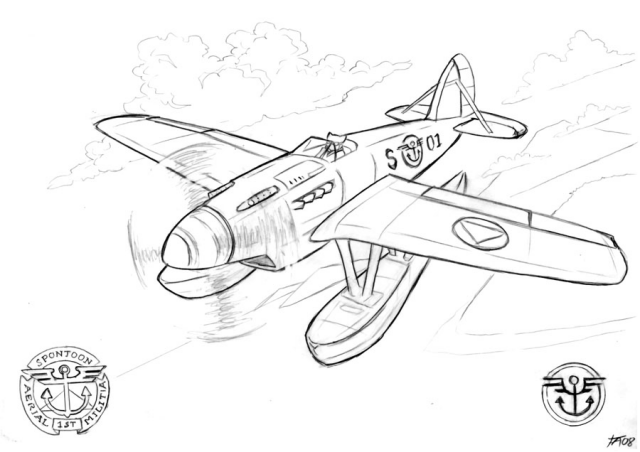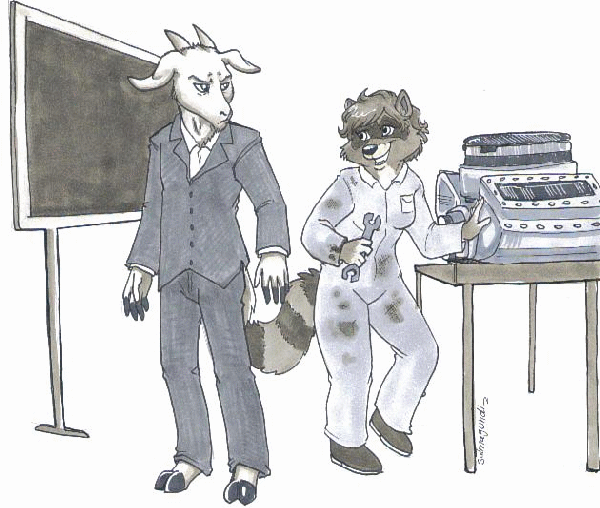
KV-9 floatplane
(Art by Fredrick K.T. Andersson from a design by Walter Reimer)
Spontoon Island
home
- contact - credits
- new - links -
history
- maps - art - story
comic
strips - editorial - souvenirs - Yahoo forum
Upload: 24 December 2008
* Upload 6 March 2013: Art by Salmagundi added *
Kypriakos-Volstead
Aircraft
A brief history by Walter D. Reimer

KV-9 floatplane
(Art
by Fredrick K.T. Andersson from a design by Walter Reimer)

* Stavros Kypriakos & Sally Volstead - (Larger file here - 330 KBytes) *
Rain Island aero-engineers - airframe design & engine design
Art by Salmagundi - http://www.furaffinity.net/user/salmagundi/
|
Kypriakos-Volstead
Aircraft: a brief history
© 2008 by Walter D. Reimer Excerpt
from
The Wings of the Thunderbird: Rain Island Aviation 1913-2000 By James Howser Seagull Literary Collective, 2008 The Magic Letters
For many Rain Islanders, the mere mention of the two letters “KV” is enough to engender a sense of national pride and accomplishment in the field of aviation. Although they were both immigrants to the Anarchcracy, Sally Volstead and Stavros Kypriakos’ long association and their shared pride in their adopted country gave birth to some outstanding designs that still affect Rain Island’s airplane industry today. Stavros Kypriakos was born in Athens, Greece in 1871 to a well-to-do family. He very early on displayed a high mathematical aptitude, prompting his father, a prominent lawyer, to obtain admission for his son to the University of Vienna. After graduating with the highest honors in 1893, Kypriakos was offered a teaching position with the engineering faculty at the Sorbonne. At about this time he began to show an interest in aerodynamics, building off the work of Cayley, Chanute and Lilienthal. Using the latter’s published works, Kypriakos designed and built a glider that he demonstrated by flying it as a kite before using it to carry himself. His first flight in his glider, which he dubbed Ikaros, was on October 21, 1899. He began to explore the possibilities of powered flight, but was unable or loath to be a subordinate to any of the other aviation pioneers who were working toward the same goal. Looking for a suitable country in which to pursue his research, Kypriakos emigrated from France and made his way across the United States to the young country of Rain Island. He explained to his grandson John in 1931 that “The old countries are busy enough; let a younger nation have the benefit of my presence.” He applied for and received a teaching post at the Polytechnic College, lecturing on mathematics and aerodynamics while designing airframes. He would test these as part of his teaching, challenging his students to point out the flaws in the designs and ways of improving them. His dream, however, was of achieving powered flight; since the Wright Brothers had successfully proven the concept in 1903 the race was on to improve upon the basic kite shape of the airplane. New aircraft companies were springing up like mushrooms, and it was in this atmosphere that Kypriakos first met Sally Volstead. Volstead had been born on a farm near Windsor, Ontario in 1880. Described by her family as a tomboy, she showed a mechanical streak and was always interested in how things worked. One winter morning her father discovered her in the act of reassembling his tractor’s engine (she had spent the entire night disassembling and examining it). Much to his surprise, the rebuilt engine worked much better than it had previously. Owing to the prevailing attitude toward women who wanted to get their paws dirty, Volstead was not permitted to explore her desired occupation. She left home in 1902 and found herself in Seathl by 1904. Apprenticing herself to an engineer with the Transportation Collective, she worked as a mechanic and enjoyed the spirit of egalitarianism that from its independence had distinguished the young nation. The two met in 1912, while Kypriakos was trying to find a company or person to build the engine he felt was necessary for his new designs. Volstead, lacking a higher education degree but gifted with her way with machines, was hired and put to work designing an engine that would minimize weight while maximizing power. The result was the Kypriakos K-2 (the number 1 was felt to be tempting fate), known as the Mule for its great strength in hauling cargo as well as for its sometimes temperamental handling characteristics. Powered by Volstead’s first effort it was woefully underpowered at first; a later variant came out a month later and the K-2 Mule was unveiled to the public on its first flight, April 17, 1917. It is interesting to relate that, like Deperdussin and some other European designers, Kypriakos never built a biplane; the K-2 was a low-wing monoplane of mixed wood, metal and fabric construction. It could, however, carry nearly its own weight in pilot and cargo owing to the power of its engine. This was the first in a long line of Volstead engines; called the Big Baby, it was a six-cylinder water-cooled gasoline motor developing 120 horsepower which gave the plane a top speed of over ninety miles per hour. Both designs were immediately successful and both were built in large numbers for the various short-haul cargo concerns that supplied the islands of the former Rain Coast. In 1919, building on their initial success, the two small companies merged to form the KV Works, and the company was moved to Port Vancouver. A new design, with greater range and cargo capacity, soon appeared: The K-3 Quarterhorse, powered by the famous Volstead Flat Four four-cylinder air-cooled engine (it is still produced today; waw.kvworks.co.ri). Unlike the Mule, the Quarterhorse could be fitted with floats for water landings, increasing the plane’s versatility. KV’s success soon drew the attention of Rain Island’s Military Collective after it was established by plebiscite in 1920. The new military wanted up-to-date planes for its new Air Arm, and after some competition KV and Neil Bosanquet were asked to submit prototypes for a transport, a fighter and a bomber. The KV-1 fighter was completed and first flown in June 1920; it was distinguished by being the first all-metal RINS aircraft as well as being purposely designed as a seaplane fighter and largely streamlined. It sported a top speed of nearly 100 mph and was armed with two machine guns. Bosanquet’s design hewed to ideas of the immediate post-War era, and was dropped after two test flights. Bosanquet’s transport, however, was accepted immediately. The KV-2 bomber, on the other paw, was a dismal failure. The airframe was too heavy and the plane’s three Volstead engines were not powerful enough; the plane earned the nickname BAS (‘Burial at Sea’) after it collapsed during its first flight and plunged into the harbor, swiftly sinking out of sight. Rain Island accepted the Bosanquet transport and the KV-1 fighter, but decided that it would purchase bomber aircraft from other countries (leading to the acquisition of the Barling bomber from the United States in the late 20s and early 30s). Undaunted, both Kypriakos and Volstead returned to the drawing board and in 1930 presented the Air Arm with the KV-3, a seaplane (technically a flying boat) powered by two Bulldog engines that gave the plane a top speed of over 150 mph. Further, it handled beautifully and had a very long range. The Air Arm accepted it with some modifications for weapons (two, later four, license-built Bruining machine guns) and attachment hardpoints. The KV-3 went on to serve in the Pacific Wars in bomber, torpedo plane and reconnaissance roles. In terms of fighter design KV enjoyed a near-monopoly until they unveiled the KV-9 in 1935. This plane came in two variants, single-seat and a two-seat trainer. Fast (top speed 265 mph thanks to its Bulldog II engine) and maneuverable, it was nonetheless a stable gun platform for its four machine guns. It was the state of the art in seaplane fighters until the Hawker Sea Demon was deployed to the British colony of the Gilbert and Sullivan Islands in 1936. Although the KV-9 had proven itself a capable plane and adapted well to the stress of catapult launches from the RINS’ seaplane carriers, a new fighter was needed, faster still and even more nimble. The two collaborators were a study in contrasts. Kypriakos was imperious and domineering, with a temper best described as ‘volcanic’ and capable of swearing in Greek, German and English – usually at the top of his voice. When not berating his students, he was moody and driven. Volstead, on the other paw, was an outgoing personality known for her cheerful demeanor and good disposition. Kypriakos married in 1930, while Volstead never married (although she did have two children, Amy and Scott, by two lovers). Kypriakos felt that participating in the 1936 Schneider Cup would not only showcase his and Volstead’s work but would provide useful information on designs and engines. Racing in 1936 was not to be, since the engine was not yet ready, but sights were set on the 1937 event. The Rain Island entry, known as the KVR Special, was immediately nicknamed The Flying Forest by the pundits and bettors at Spontoon when it was unveiled that August. Its twelve-cylinder supercharged Volstead Victor engine enabled it to post a speed mark of nearly 400 mph, and its airframe and skin were constructed of laminated Sitka spruce (Kypriakos felt that the natural material would give the plane the flexibility necessary to overcome the stress placed on the plane by the engine’s torque). The Special did not finish the Schneider Cup race that year, the victory going to the German team. The reasons for the loss were the failure of the engine’s oil radiator and the torque-induced tendency of the aircraft to roll to the right. The company’s chief test pilot, Running Salmon, stated later that flying the Special was akin to “riding a bucking bronco – but less comfortable.” Kypriakos had been present at the races. It was hoped by the various newspaper reporters present that he would fly into one of his signature rages when the Special failed to finish, but to their disappointment he didn’t display his temper. Kypriakos said nothing but returned immediately to Port Vancouver. By the outbreak of hostilities in the northern Pacific in 1940 the kinks in the engine and airframe designs had been worked out and the RINS’ new fighter, the KV-10, was accepted for the Air Arm. Powered by the Volstead Victor, the new plane exceeded its expectations and was a major part of Rain Island’s war effort. ***
Sally Volstead died in 1944; it
was said by many after her funeral that it was the first time anyone
had seen Kypriakos cry. He himself lived on until 1969, dying at
the age of ninety-eight, surrounded by his family and regarded as the
dean of Rain Island’s aircraft industry. At both funerals, examples of their successful, decades-long collaboration (from the K-2 Mule to the jet-propelled KV-20 Arrow fighter) flew over the grave sites. |